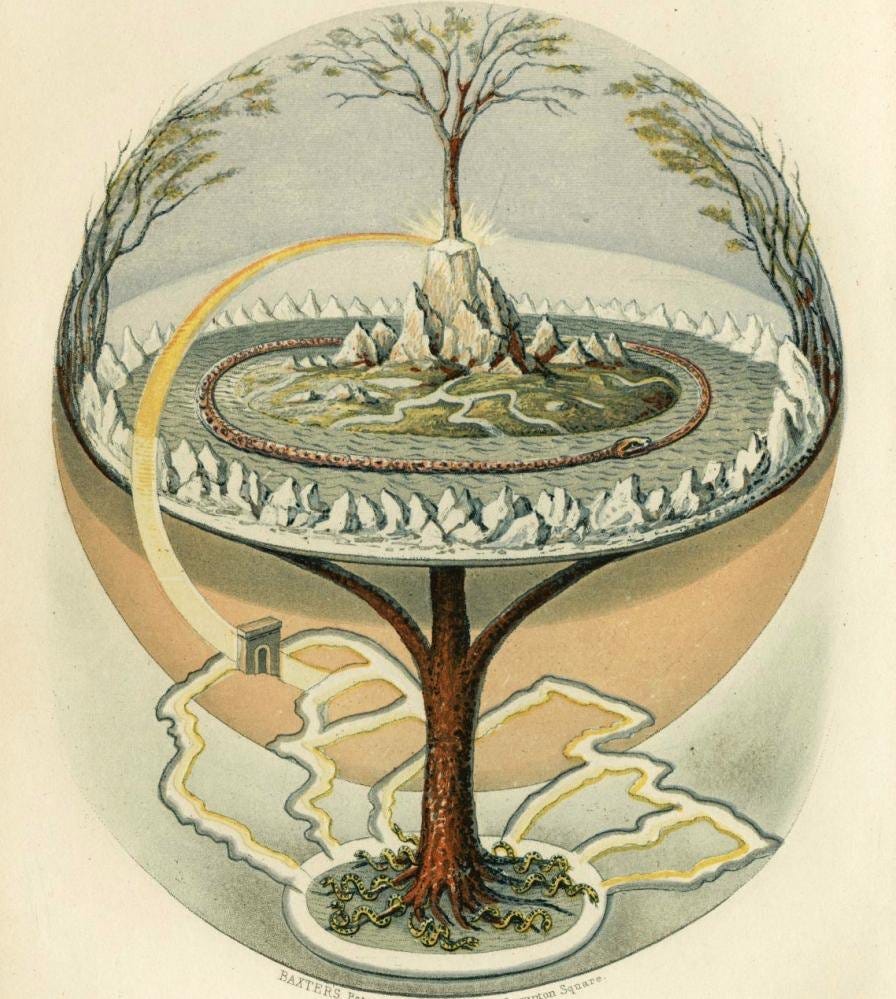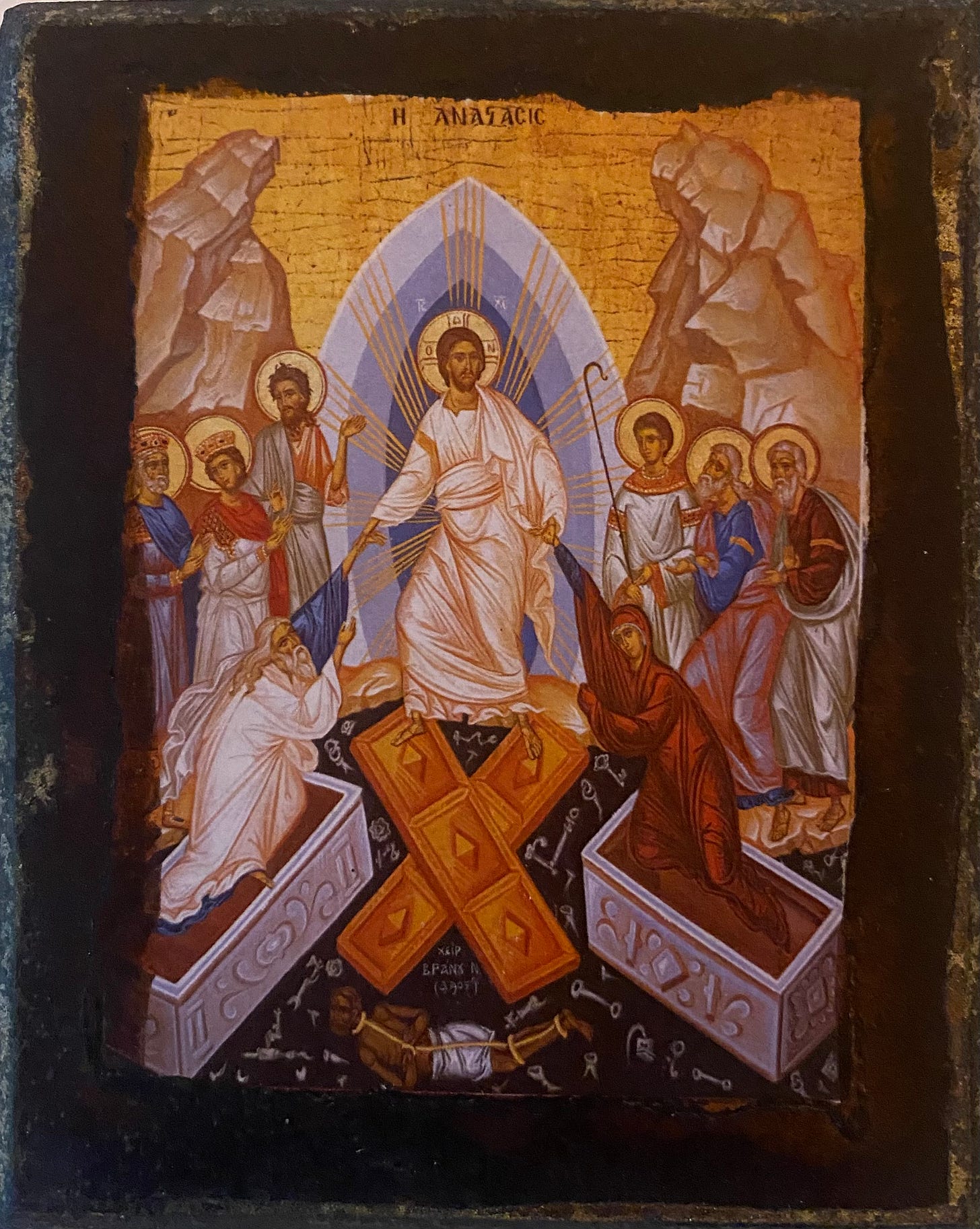Eucatastrophe: snatching victory from the jaws of defeat.
Hello everyone, Sam here. On this Easter holiday, only one thing is to be meditated upon. Given the nature of the day, this will be a shorter entry; now is not the time to be inundated with emails, long pontifications, or the temporal. Instead, we will briefly glance at that light which infuses and binds all things: Christ and His passion.
Biblical cosmology is a topic that has been written about extensively for millennia. It is too deep and too rich a realm to simply play loosely with. Nevertheless, given the abundance of pearls buried within every page, it is permissible to stop for a moment in awe, if not in understanding. One such pearl is present throughout the entire biblical story. It is a pattern that one can perceive at the highest metaphysic of the Bible and in the lowest detail of its shortest story. In a word, it is eucatastrophe: turning death into glory - the signature of God.
The Pattern
Put succinctly, the story of Christ is about the very highest incarnating as the lowest, serving the lowly, and bringing all back up into Itself. What is left for those in posterity is a mode, a spirit, to be called into and the opportunity to participate in this divine narrative. By doing so, one is changed, born again into something greater than oneself; and saved from the inevitable bonds of death and decay. In the Eastern tradition, this is called Theosis, the process of deification, ascending the divine hierarchy up even into God Himself. In Western traditions, it is Sanctification, being reconciled with God and made holy. If you are a participant in either sphere, forgive the quick presentment. Whether you subscribe to divinization or sanctification, at least one thing is shared: grace as the impetus of renewal and glory. And as Christ, grace itself, reveals to us, “Behold, I make all things new.” (Rev. 21:5).
“For God became man so that man might become god.” - St. Athanasius
Where can we see this renewal, this signature of God, this turning of death into glory? The obvious answer is the life of Jesus Christ; though, this pattern plays out everywhere and all of the time. I can think of only too many examples to highlight and flesh out, and no doubt there are far more that I have overlooked or am unaware of. Most people know of the passion of Christ, how the Son of God, the Word -the logos behind all things-, incarnated in the world, spotless and sinless, to suffer and die at our hands for the atonement of Sin and renewal of all. In forgiveness and love, He took our rightful place at the limit of excruciating death and redeemed our nature. This is the ultimate example, but if we take its lens and investigate the particulars of turning death into glory, some staggering details emerge.
Paradise Lost
Through His grace, Christ, rather than razing an upside-down world, inverts it. He raises up the bottom and calls us to do the same. The pattern of His life reflects this. Born into the world not receiving a feast but rather laid in a manger, a trough, to be offered as sustenance. The child who teaches the rabbis. The Lord who washes the feet. The king who rides a donkey. He is the innocent man convicted; the loyal one betrayed; the sinless taking the place of the murderer. He bleeds in the Garden of Gethsemane for the crime committed in Eden. He spends His days with prostitutes, lepers, the poor, samaritans, and gentiles. He says things such as, “The first shall be last and the last shall be first.” His torturers ridicule him with staff, cloak, and crown, mockingly genuflecting before a humble and beaten man. Along with Christ, the message Jesus of Nazareth King of the Jews is nailed to the cross. The irony is palpable. And irony is inversion.
When mankind fell after having eaten from the forbidden tree, one consequence was that the earth would then put forward thorns and thistles - dead idiosyncratic parts that, like a tumour, sprout out of beauty. Christ, the new Adam, wears these very thorns as a crown. He has brought the dead wages of sin into Himself and wears it as a mark of His renewal.
In Christian tradition, specifically within the Golden Legend, there is the notion that the wood of the True Cross descended through the generations beginning in the Garden of Eden. A branch of the Tree of Knowledge was given to Adam’s son, Seth, by the archangel Michael. It was planted over Adam’s grave and Seth was told Adam would be healed when the branch bore fruit. Certain traditions hold that this same branch would go on to become Moses’ staff and later planted in Jerusalem by David. Solomon would fell the growing tree and use it for the construction of his palace. Finding it unfit, it was instead used for a bridge. The Queen of Sheba, when on her way to visit Solomon, came to this bridge and refused to step on it, prophesying that a great man would be lifted on its beams, signifying a new covenant with God. The wood was buried for generations until it reemerged to be fashioned in the shape of a cross and used by Romans for their crucifixions. Then did the branch bear its fruit, as Christ was crucified upon it - that very tree which opened the path to death.
When Christ breathes His last, he quotes Psalm 22, “My God, my God, why hast thou forsaken me?” A troubling question for those who followed Him to the bitter end. The sky grew black. Grace had descended down, but seemingly to defeat.
Paradise Regained
O death, where is thy sting? O Hell, where is thy victory? - 1 Corinthians 15:55
Christ gave up His spirit, was taken down from the cross, and laid in a tomb. But it was not the end. As the story tells, Christ descended into Death. But what does that mean? In Christianity, it is called the Harrowing of Hades -when the ultimate trick, the final inversion, is pulled- when God reveals His hand.
In the extrabiblical gospel of Nicodemus, the tradition can be further explored, but suffice it to say Death believed it had won. This sinless man had entered its cold domain. Here comes the Son of God, and we have consumed Him alongside His creation. But it was not so. Instead, like a piercing light that rends a veiling shadow, Christ rode in on liberation. As Hades smugly believed itself to have consumed the dead Christ, much like the crown of thorns, it was Christ who took death into Himself. We as Christians believe that Death was emptied on that day. On this day. The highest descended into the very depths, the limit of creation, and brought it back up into itself.
Above is an icon of the Anastasis, where we can see Christ pulling Adam and Eve out of their tombs; death is abolished, crushed under his very gates. The catastrophe of mankind undone in the final moments of ostensible defeat. The hold of death was turned to the glory of life.
In that hour, the very tree which opened the path to death became the Tree of Life, whose fruits opened the path to life. Grace had ascended up turning all into glory. The tomb which Christ would exit from three days later would be a new womb; the promise for all.
God turning death into glory fills the whole biblical narrative. It is Noah and his ark braving the flood and the dove returning with life; it is Isaac being spared on the altar of sacrifice; Joseph being sold into slavery by his brothers only to return in victory; the Hebrews enslaved by the Egyptians and, plucked from their chains, sent to a land of their own; Daniel in the lion’s den; the prostitute Rahab and her scarlet cord. The list is inexhaustible. But, what’s more, this signature of God is in your own life, and you can wield it.
We are told to love our enemies and to pray for those who persecute us. Why? Consider the act of forgiveness. It is a washing away of past transgressions; the debt is paid or no longer due. It is a new beginning for both victim and perpetrator. Throughout your life, you will be both. Every time you forgive or are forgiven, renewal is to be found; a new life begins. When an enemy is turned into a friend or a scorned person regains your love, a death has been turned to glory. You hold this very power, we’ve been given the example and shown its staggering effects. Grace is the impetus of renewal, and His hand is in all things Good.
Christianity began as a counter-culture religion. It then gave birth to the most free and prosperous societies to ever inhabit the earth. As faith around the world now wanes and our culture slips well into decadence, Christianity is counter-culture once more. And though it may be tempting to despair as we face the tumult of our time, remember the signature of God. In this Easter season give thanks for the challenges ahead as we get to bear witness once again how Christ turns death into glory.
God be with you,
Sam







This was a wonderful reminder of what Easter is and why it is so important for all to revisit. The article was beautifully written. Thank you Sam